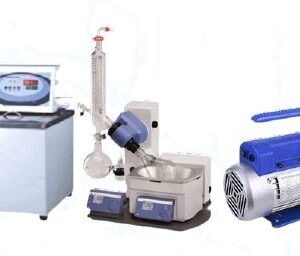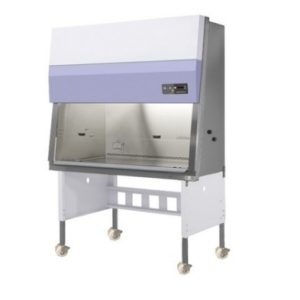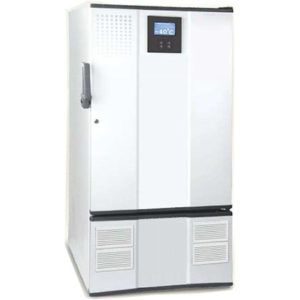REFRIGERATED TABLE TOP CENTRIFUGE
Make Dinesh Scientific
DESCRIPTION:
With the use of centrifugal force, materials with varying densities can be separated in a sophisticated laboratory device called a chilled centrifuge. It works on the idea that the denser particles in a sample travel outward and form different layers when it is spun rapidly. The following is a thorough explanation of a chilled centrifuge:
MAIN COMPONENTS:
ROTOR: The sample tubes or containers are held in place by the centrifuge’s rotor. It creates centrifugal force by spinning quickly.
MOTOR: The rotor is driven by a strong motor, which enables high rotation rates.
CONTROL PANEL: Users can adjust centrifuge process parameters like speed, temperature, and duration via the control panel.
REFRIGERATION SYSTEM: This feature separates a conventional centrifuge from a chilled one. It has a cooling system that keeps the centrifugation temperature low, which is essential for protecting the integrity of samples that are sensitive to temperature changes.
- 2. FUNCTIONALITY:
CENTRIFUGATION: The main purpose is to rotate the samples quickly such that the denser components settle to the bottom of the tubes.
REFRIGERATION: The centrifuge’s internal temperature is regulated by an integrated refrigeration system, which permits sample separation without jeopardizing the integrity of materials that are sensitive to temperature changes.
3.APPLICATIONS:
CELL separation: Cells are divided according to density in biological research.
PROTEIN PURIFICATION: vital for separating and purifying proteins from complicated mixtures in biological investigations.
DNA AND RNA EXTRACTION: helps to separate nucleic acids from biological materials more easily.
CLINICAL DIAGNOSTICS: utilized in clinical labs for a range of diagnostic procedures, including the separation of blood components.
TEMPERATURE CONTROL:
- Depending on the model, the refrigeration system can normally regulate the temperature between below ambient and below zero.
SAFETY FEATURES:
- LID LOCKING MECHANISM: Makes sure the centrifuge lid stays firmly closed while it is in use..
AUTOMATIC IMBALANCE DETECTION: In the event of an imbalance, stops the centrifuge to protect the samples and the device.
CAPACITY AND SPEED:
SAMPLE CAPACITY: To handle a variety of sample sizes and kinds, refrigerated centrifuges are available in a range of sizes and rotor designs.
- SPEED CONTROL: Users can adjust the centrifugation settings for various applications using variable speed control.
USER INTERFACE:
Digital Display: For convenient monitoring of the settings, remaining time, and speed, the control panel usually has a digital display. In conclusion, a refrigerated centrifuge is a multipurpose laboratory instrument that combines temperature control and centrifugation principles, allowing scientists to precisely separate and analyze samples, particularly when working with materials that are sensitive to temperature.
FEATURES:
- Benchtop Refrigerated Centrifuge:
- Robust C.R.C. structure with powder-coated finish
- A centrifugal bowl made of stainless steel for added protection and simple cleaning.
- Equipped with an electronic drive and a well balanced brushless motor.
- 20 characters in 4 lines. LCD display for rpm, cf, set and run times, and set times
- A digital timer with a range of 0 to 99 minutes, lid lock, quick spin, and rotor identification.
- There is an automated dynamic brake and an imbalance detector.
TECHNICAL SPECIFICATIONS:
| MODEL | DS-RC-AR |
| Temperature | -15°C to -10°C & 35°C to 40°C |
| RCF (Relative Centrifugal Force) | 25000 x g +/- 5% |
| Speed | 15000 RPM +/- 5% |
| Motor Type | · Microprocessor
· Direct · Brushless induction low profile motor |
| Pre-selection | RPM and Force x g |
| Rotor Compatibility | Microtubes (1.5-2.0ml) |
| Safety Features | Imbalance rotor detection, crash-proof construction, alerts, errors |
| Acceleration and Deceleration Rates | >5 acceleration and >5 deceleration rates |















Reviews
There are no reviews yet.